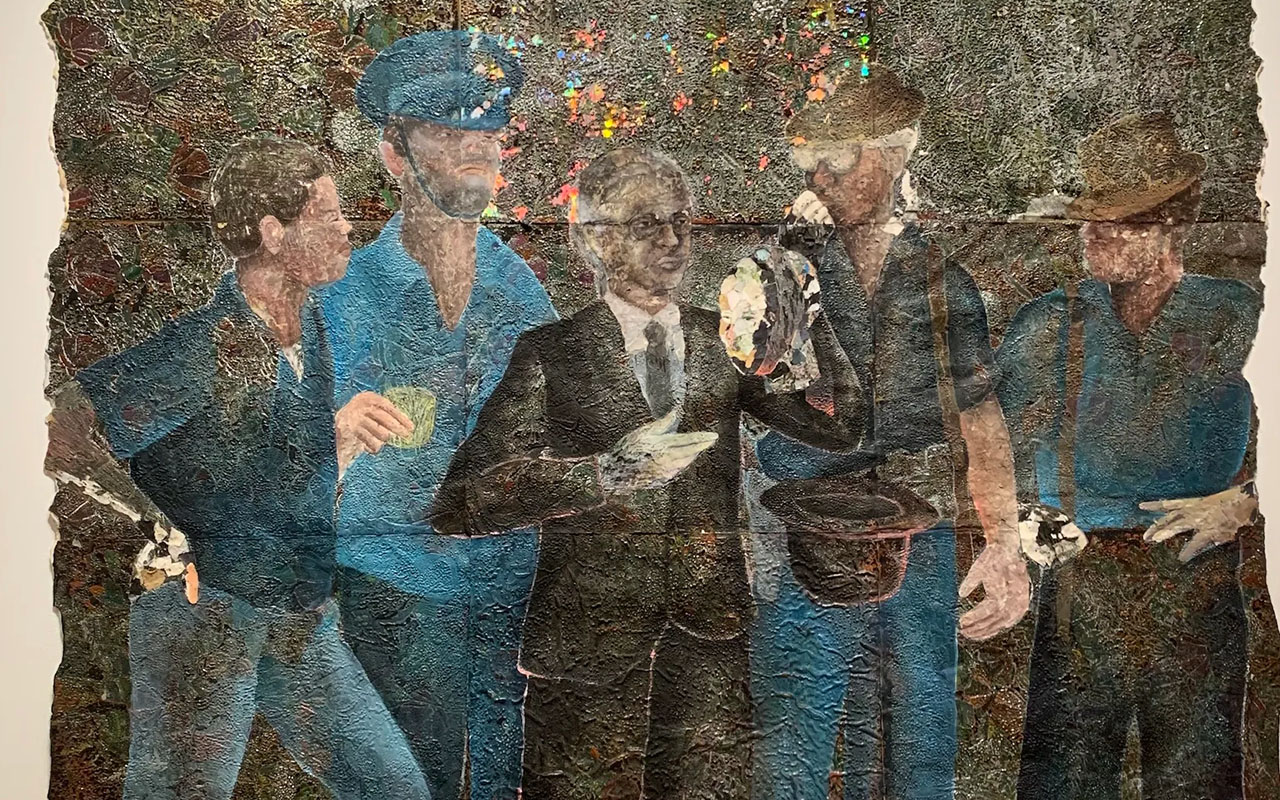WILLIAMSTOWN, Massachusetts — How do you begin to tell the story of Haiti? Starting with the arrival of Christopher Columbus in 1492, the island nation was subject to harsh colonial rule first by Spain, and then by France, which forcibly transported nearly 800,000 Africans to the island as enslaved labor for its coffee and sugar plantations. The success of the Haitian Revolution and the creation of an independent state in 1804 was followed by economic and political instability, war, two decades of United States occupation, autocratic leaders, a series of natural disasters, a coup d’état, a presidential assassination and, more recently, rampant gang violence and the highest levels of maritime migration to the US since the 1990s.
Kathia St. Hilaire was born in 1995 in Palm Beach, Florida, to Haitian parents who immigrated to the US in an earlier wave of the diaspora. Invisible Empires, her current exhibition of mixed media wall hangings and sculptures at the Clark Institute, is her attempt to tell the many stories that make up Haiti’s long, violent, complicated, and culturally rich history, from the first arrival of enslaved Africans in the 16th century to present-day diasporic Caribbean communities, such as the Palm Beach neighborhood in which she was raised.

Like the narratives she portrays, St. Hilaire’s artistic technique is layered and complex, and reflects vernacular cultural aesthetics and practices. Her works often begin with relief printing, making as many as 40 or 50 impressions in the same area to build up intricate textures on canvas, paper, or steel. She then sews, staples, or weaves the material together to create a larger surface, onto which she continues to paint and collage other elements, such as banknotes, price tags, banana stickers, aluminum, rubber tires, and skin-lightening cream packaging. As wall hangings, the works suggest drapo, the ceremonial flags of Haitian Vodou, a syncretic religion formed from West African and Roman Catholic traditions (another instance of layered complexity). One of its central rituals is represented in four sculptural works, a series of Boulas (2023), or drums, which also helped formerly enslaved people communicate during the Haitian Revolution.

St. Hilaire documents resistance fighters of a later era in her Cacos series (2023), highlighting three leaders of the guerrilla movement that fought against the 1915 US invasion and occupation of Haiti: Rosalvo Bobo, Benoît Batraville, and Charlemagne Péralte. Each of the roughly square works pictures a figure riding on a brown horse and a trampled white horse. Bright green bushels of bananas lay on the ground in one; workers carry them in another. Densely woven materials and printmaking reliefs are visible through the artist’s painted figurations, giving the works a pronounced texture reminiscent of a medieval tapestry, along with all the narrative importance such an object would convey. Collaged elements (Chiquita banana stickers, Latin American banknotes) allude to the continued role of the US and other foreign interests in determining the fate of Haiti’s economy and citizens.
Other works demonstrate solidarity with Latin American countries that have suffered under colonial and neocolonial intervention. “Mamita Yunai” (2023) memorializes the 1928 Banana Massacre, in which Colombian soldiers fired machine guns into a crowd of workers striking against the United Fruit Company, killing more than 1,000. In St. Hilaire’s depiction, leaflets honoring the dead fall onto a heap of bodies and a brown horse, while four vertical strips of weaving interrupt the figurative elements. These narrow, bronze-colored sections recall both the security ribbons embedded in some paper currency and redacted sections of government documents; perhaps the artist is suggesting that the two are closely intertwined.
St. Hilaire also holds the Haitian government to close scrutiny, as in “Head Whisper” (2022), which portrays François Duvalier, a democratically elected president of Haiti who turned to increasingly violent and dictatorial tactics during his 1957–71 rule. “Papa Doc” developed a mystical cult of personality, styling himself as a Vodou priest who purportedly kept the head of a political opponent in his closet. Here, St. Hilaire shows the suited despot flanked by three taller men in blue jeans and casual collared shirts, plus another who appears to be a police officer. On an otherwise unadorned dark green and brown background, small pieces of iridescent paper are collaged above Papa Doc, who holds a disembodied head above an upturned black hat, evoking a magician conjuring a rabbit. If stories have the power to exalt the forgotten, they can also dethrone the powerful, transforming a brutal ruler into a mere storybook villain, if only in our minds.
Two large works without any figures serve as chronological bookends. In “La Sirene” (2020), curved sections of canvas and aluminum are pieced together in undulating waves of blue, green, and silver to represent the Atlantic waters that first brought enslaved Africans to Haiti. St. Hilaire printed the materials with botanical illustrations to signify the seeds that African people often braided into their hair before their harrowing journey to a new land. Water is also the central element of “David” (2022), which references the hurricane that struck Haiti in 1979. In one grand, swirling gesture, St. Hilaire takes in the disparate scraps from her studio floor in an attempt to emulate the fictional storm of Gabriel García Márquez’s One Hundred Years of Solitude, one that eradicates a city and all memories of it. Yet if Invisible Empires demonstrates anything, it’s that memory is an ineluctable force — determining countries, shaping destinies, haunting families — and it urgently wants to be made visible, through buried histories brought to light, religious rituals given new form, and physical bodies inspired to drum and paint.





Kathia St. Hilaire: Invisible Empires continues at the Clark Art Institute (225 South Street, Williamstown, Massachusetts) through September 22. The exhibition was co-organized by the Clark Art Institute and the Speed Art Museum, and co-curated by Robert Wiesenberger and Tyler Blackwell.

